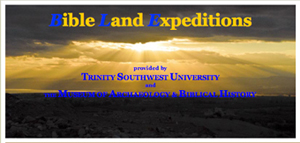
Another BLE Bible Lands Expedition study tour is planned for October 2010, God willing. Dr. Steve Collins and myself will be leading the tour. This is an exciting adventure travelling through Jordan and Israel with the likely outcome that you’ll never read your Bible in the same way again! We do not take more than one bus full, so you really get to know each other well. There are a few places left, so have a look at the website and tour overview!
Category: Jerusalem
“Solomonic Wall” found in Jerusalem
The confusion in the reporting on this wall was summed up in one sentence by Neil Silberman: “Dr. Eilat Mazar is at it again– running to the press before properly submitting her finds to serious archaeological scrutiny.” This has been my personal experience going back to 1986.
I do believe that she is a good archaeologist, but this running to the press, without giving scientific reasons for her conclusions is totally unacceptable. People are no longer prepared to believe statements that are not backed up with facts. It gives Biblical Archaeology a bad name.
Barnea Levi Selavan of the Foundation Stone organisation, which, together with Ateret haCohanim, has the aim of purchasing and restoring “ancient homes in the Old City which are occupied by young and idealistic yeshiva families and students who have breathed new life into the heart of Yerushalayim”, wrote this to me:
“Eilat explained to the press that she reached bedrock, she dug under the floor and found 10th century pottery in the fill under the floors. most media reports did not quote this. she said no evidence of Canaanite structure earlier here. Typology of pottery distinctively Israelite. Original floor preserved in two places.”
So, all that was done, as I already presumed, was digging down deeper in previously excavated areas and finding 10th century material. How that fill relates to the wall segments is still unclear.
Solomon’s Temple
Where Heaven and Earth Meet: Jerusalem’s Sacred Esplanade
A new book on the Temple Mount was published today in Jerusalem. It has been widely reported, for example here, here, here and elsewhere. Various Jewish, Muslim and Christian authors discuss the meaning of the Temple Mount, called in this book the “Sacred Esplanade”. The book is a collection of essays by renowned scholars on the history, archaeology, aesthetics and politics of the place that Jews revere as the location of their two ancient temples, and that now houses the Al Aksa Mosque, the third holiest site in Islam. The aim was to “to try to dispel insensitivity born of ignorance.”
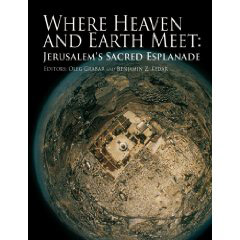
According to Miriam Feinberg Vamosh this aim was not achieved: “Despite their best efforts to produce an ecumenical book, the editors of this beautiful volume on the Temple Mount could not induce their Jewish, Christian and Muslim authors to agree on a single narrative, a fact that only confirms the complex and deeply held variety of traditions associated with the site.”
The wanton ignorance of archaeological evidence of the ancient temples, despite the many discoveries which prove that a Jewish Temple once graced the Temple Mount, has sadly led many Palestinians to deny any real Jewish attachment or claim to the plateau.
Nevertheless, I look forward to reading this book.
Source: Joe Lauer
Coins from ancient Jewish revolt found near Temple Mount on display
A peek into excavations near the Temple Mount
Just over a week ago I led a tour through the Western Wall tunnels and saw some very deep excavations between the foundations of buildings which date from the Mamluk period (14th-15th Century AD). Excavations are continuing until bedrock is reached. Several mikva’ot (Jewish ritual baths) from the Second Temple period were observed – an indication that Jerusalem was indeed Jewish at the time. Here is a picture I took of one of the deepest excavation pits:
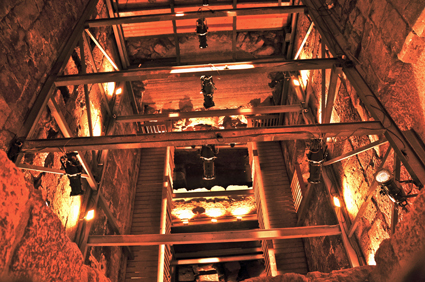
Joe Lauer sent me this report, showing that not everybody is happy with the excavations. The title of the article is misleading, as no excavations are conducted inside the Temple Mount. The Muslim claim that tunnels are dug within the Temple Mount are not true. The whole area lies to the west of the Temple Mount. An invitation to tour the area was turned down by Muslims. How can one reach understanding when dialogue is refused?
New Model of the Second Temple in Jerusalem
A model of the Second Temple has been placed on the roof top of the Aish haTorah Yeshiva building overlooking the Temple Mount. It appears to have been modeled on the Holyland model of the Second Temple, built in the 1960’s. This latter model was built at a scale of 1:50, so the new model with its scale of 1:60 is slightly larger. This report includes a video showing how the 1.2 tonne model was lifted into its place.
The most dramatic aspect of the model is its location, just 300 yards from where the original Temple stood. Paradoxically, this has turned out to be a drawback, as, in order to allow ease of access, the model Temple faces west instead of east. Although this is hugely disorienting, the model with its hydraulic system, which allows the interior of the Holy of Holies to be seen, provides another rich experience for lovers of Jerusalem.
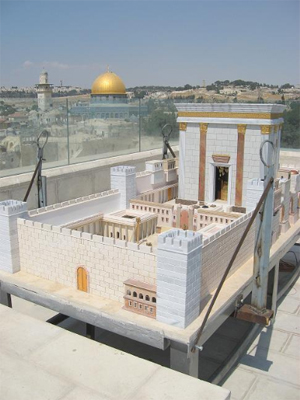
Source: Joe Lauer
Temple Mount Mikveh
Zachi Zweig, an archaeologist who is involved with the Temple Mount Sifting project, kindly send me the paper [in Hebrew], which he gave at the recent conference on the Temple Mount at the Bar-Ilan University. I commented on this find in an earlier post. Here is an abstract:
“Hamilton describes the discovery of a plastered cistern that was excavated below the easternmost door of the present El Aksa mosque, north of Cistern 9 [according to Warren’s numeration – see map]. The descent to [the cistern] was from west to east by means of a flight of steps, with the bottom step some 3 m. [10 feet] below the present floor of the mosque. The remains of some five steps were discerned, which were built against a plastered wall, which was about 90 cm wide [3 feet].
Unfortunately, Hamilton did not publish additional details – not one picture or plan. However, in the Mandatory Archives there was a photograph of the five steps, which descend to the opening of the cistern. The top of the steps is located some 1.50 – 2 m. [6-7.5 feet] below the present surface and to the south of it and adjacent to it, although at a little distance, there is a thick wall. This is most likely the same cistern. The steps appear to have been cut out of the rock and this points to the fact that the level of the top of the rock in this location is at about 1.50 m. [6 feet] below the level of the present pavement.”
The exit of the cistern is located deep below the level of the floor of the mosque. Hamilton dated it to the late Roman period. However, as the remains of a dividing wall can be discerned, Zachi concluded that it could have been a mikveh (Jewish ritual bath), see picture below:
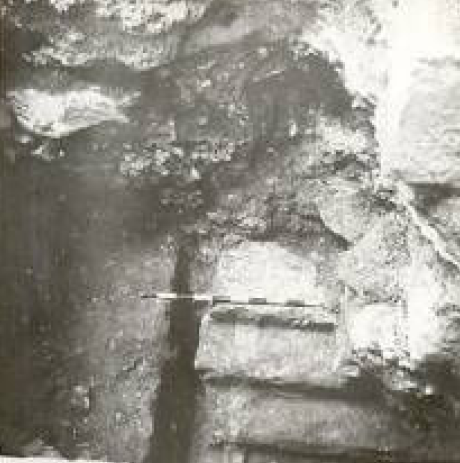
It is located a little to the east of the underground passage which leads up from the Double Gate to the Temple Mount. Ronnie Reich has identified Cistern 6 and 36 as mikva’ot, but these are located in the original Square Temple Mount. These could have been added in the Second Temple period, as they are located close to the surface and no First Temple period mikva’ot are known.
This latest one, however, is located much lower down and in the Hasmonean extension of the Temple Mount and may therefore have been one of the earliest mikva’ot in Jerusalem:
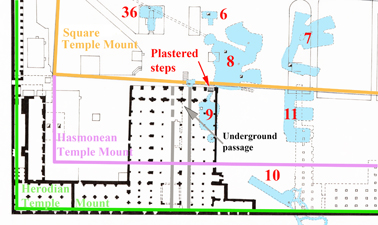 Worshipers in the Hasmonean period, who had not purified themselves before going to the Temple Mount, perhaps had the opportunity to do so in this mikveh, if it was a mikveh indeed.
Worshipers in the Hasmonean period, who had not purified themselves before going to the Temple Mount, perhaps had the opportunity to do so in this mikveh, if it was a mikveh indeed.
First Temple Period Hebrew Seal found
It is always exciting when an Hebrew seal of the 7th Century B.C. is found, as announced today here. In an excavation 100 m west of the Western Wall an impressive seal was found. It shows a Hebrew archer in Assyrian style military outfit and his name, Hagab, engraved in ancient Hebrew script next to him. At least he doesn’t look like a grasshopper, which the Hebrew meaning of this name is. The name appears in reverse, so that it would come out right, when impressed in clay.
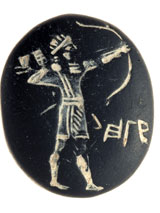
It was stated that this name of Hagab also appears in the Bible, namely in Ezra 2.46. That is where the comparison ends, of course, for this Hagab was one of the Nethinim, temple servants. Temple servants were not usually dressed in warrior’s suits.
The seal was found in an excavation, located some 100 m. from the Western Wall. This wall, of course, did not exist at the end of the First Temple period. The Western wall at the end of the First Temple period was located at least 25 m further to the east. That wall was part of the 500 cubit square Temple Mount, which was probably built a century earlier by King Hezekiah.
Temple Mount ban
Here you can read one of the latest articles on “Jews in the Temple Area: A ‘Mount’-ing Controversy”. Three rabbis, Rabbi Yoseph, Rabbi Elyashiv and Kanievsky, demand a complete ban on Jews entering any part of the Temple Mount on the grounds that the ritual purity of the area might be violated.
On the other hand, there are a growing number of rabbis, such as Rabbi Moshe Tendler, Rabbi Yehuda Kreuzer and the rabbis of the Temple Institute, who believe that Jews should be allowed to enter onto the Temple Mount, and in an interview with IsraelNationalNews, Rabbi Kreutzer cited a well-known rabbinical source: “In short, the Radbaz [a leading halachic authority from the 1500s] ruled that the Dome of the Rock is the Foundation Stone in the Holy of Holies…. He wrote that without a doubt this is the identity of the place. He wrote in a definite way the definite identity of the place,” Kreuzner reiterated. “If so, it’s possible to do the measurements.”
The “measurements” have been done already, for there is so much archaeological evidence to show that the Rock inside the Dome of the Rock is the Foundation Stone, that is indeed possible to set out the precise location of the Temple and its courts. For the last 30 years, I have used the information of Middot, Josephus and archaeology to analyze the Temple Mount.
The pre-Herodian Temple Mount was a square platform of 500 cubits, inside of which was the soreg, a partition screen to keep out Gentiles and Jews who were disqualified from entering the inner courts. Further inside was the Court of the Women and the Azarah, the court around the temple itself, which was accessible to priests only.
The location of the soreg in the southern court depends on the location of two Temple Mount mikvaot, Cisterns 6 and 36 according to Warren’s enumeration, and the soreg should be located just to the north of them. Mikvaot were used for ritual bathing, which, of course, needs to be done before entering the holy area. Even if the rabbis would stay outside of the soreg, there is ample space on the Temple Mount for them to walk on.
The Court of the Women was located east of the raised Muslim platform and the Azarah was located on this platform. By staying off the platform, rabbis could never defile the Holy of Holies, which was located inside the Dome of the Rock. Even walking on the raised platform, there is no danger of trespassing on the Holy of Holies.
If the fear of the rabbis is to tread of the area of the Holy of Holies alone, then they should stay outside of the Dome of the Rock and the rest of the Temple Mount should be accessible to them.
On the detailed plan below, the pre-Herodian Temple Mount is indicated in yellow. and the soreg in the southern court is just north of the two mikvaot. The raised Muslim platform is grey and the Herodian Temple Complex is in red.

